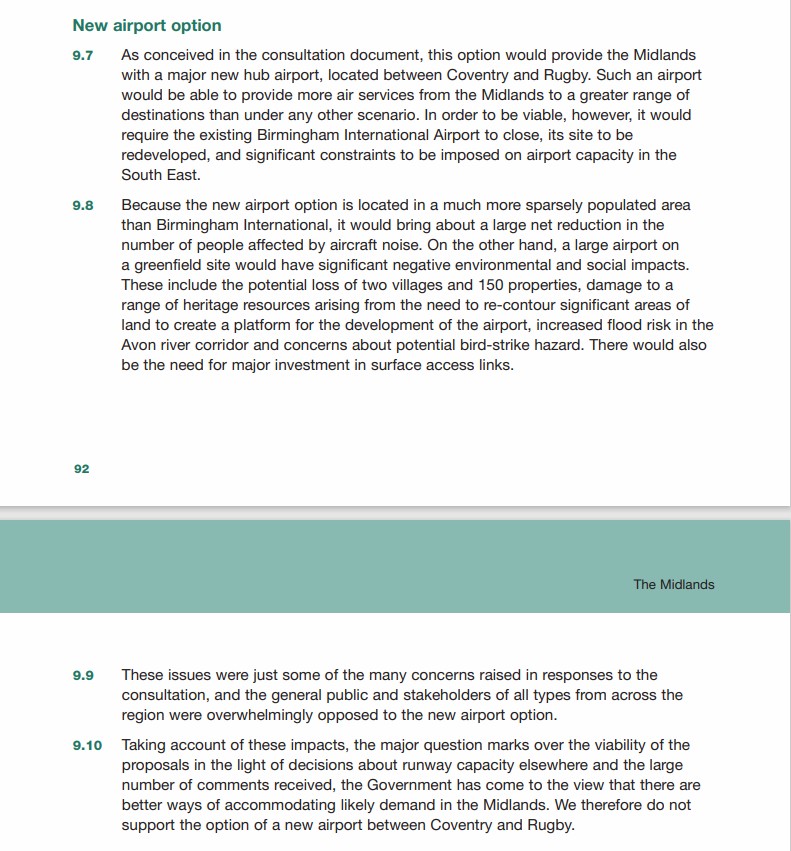Liz Parvin wrote an article for the Village Magazine in 2015 about the anti-airport campaign of 2002-03. It was the last in a series of articles that she and Keith Sinfield had written for the village magazine about village history – and those articles have been used as the basis for the historic background recorded against the various centuries on this website.
In July 2002 there was a news item on the radio and TV about government proposals regarding the future development of air travel in the UK. One of these proposals was for a brand new airport, twice the current size of Heathrow, in the Midlands. It rapidly became apparent that this new airport was to be on top of Church Lawford and King’s Newnham! The map below shows the area the airport would have covered.
It had three runways and a 16 mile perimeter. Both villages would have been flattened, including the church and the graveyard, and the railway line would have passed underneath the airport. The intention was for the airport to handle 77 million passengers a year. If this airport had been built then Birmingham airport would have been closed. There were quite a few of us who thought that this would never happen it was too crazy. However, none of us was prepared to sit back and take that chance — so the fight began!
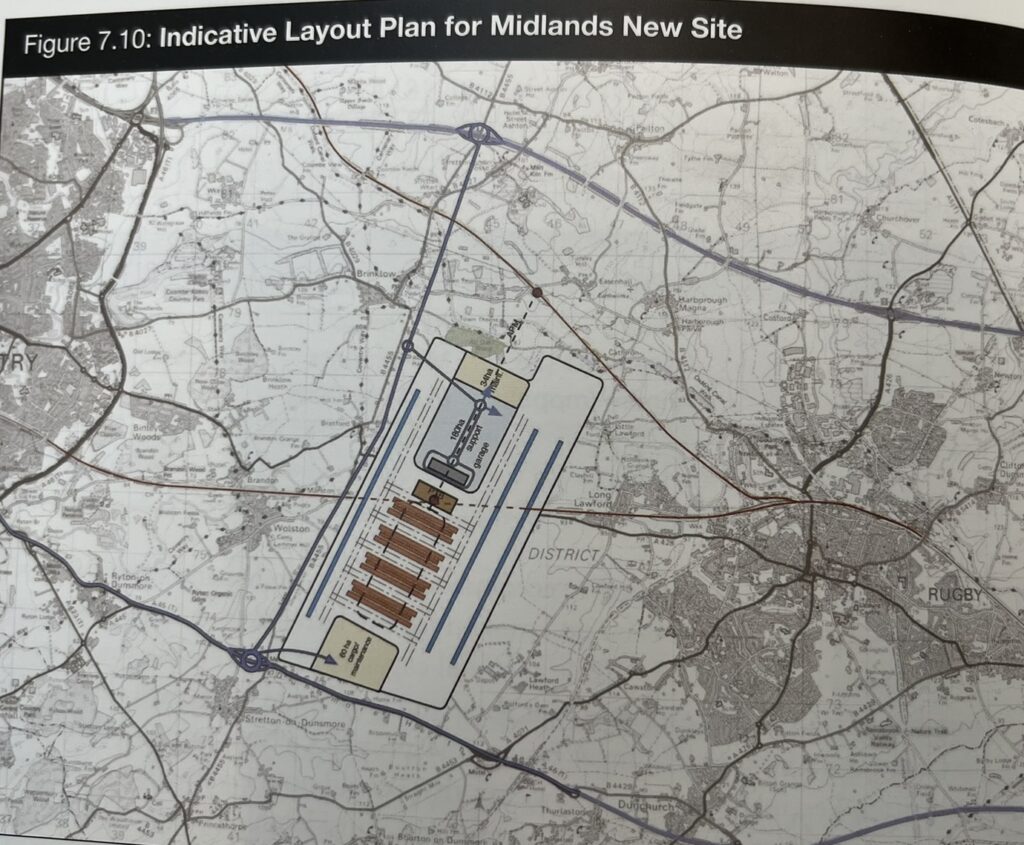
So what did we do? We had a series of village meetings and set up a village committee, chaired by Peter Hall, who lived in King’s Newnham at that time. We were at all times strongly supported by our then MP, Andy King in spite of the fact that he was from the same party as the government that had proposed the airport! He set up another committee, on which I served, consisting also of people from other local organisations, and villages which were not actually under the airport but whose lives would be blighted by the aircraft flying over and by the inevitable development of car parks, warehouses, hotels and so on. Banners and posters popped up all over the place with slogans such as
BLAIRPORT’, ‘NO, DARLING, DON’T BE RIDICULOUS’ (Alastair Darling was Sec. of State for Transport), and ‘IT’S PLANE STUPID’. (see, for example, https://www.theguardian.com/uk/2002/oct/28/transport.ruralaffairs
Both committees, and many local people, worked long and hard to produce responses to the consultation document (a large book produced by the DfT). We put forward the view that (a) the proposed expansion was not needed and was environmentally damaging and (b) Church Lawford was not a sensible place to put the airport. Our arguments against the Church Lawford site included the flooding risk, the biodiversity of the area and the large number of historical artefacts (1000) found under the area of the airport as these were indicative of the wealth of history in the area.
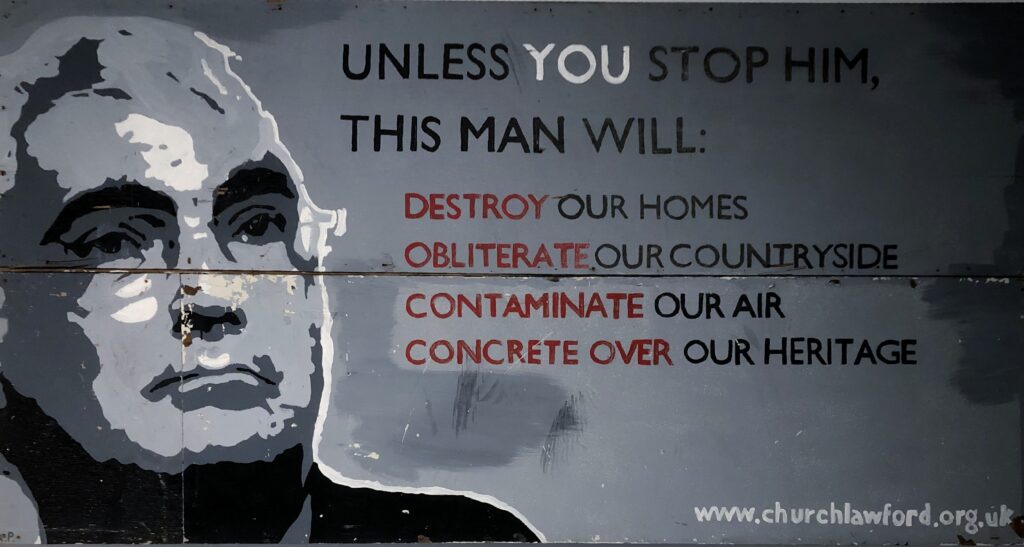
In the autumn of 2002 the DfT came to visit Church Lawford and erected a huge temporary building on the recreation ground. They put up posters with information (the same as the book) but also brought with them ‘experts’ from the DLL and various other consultancy organisations who had been working secretly on this proposal for 4 years. They insisted on hiring the Reading Room (the 1912 building that stood where the Village Hall now is) for toilets and refreshments, but then omitted to tell anyone that they were there! However, they paid for the Reading Room to be redecorated and that helped to keep it going until it was replaced in 2007, so we could not complain!
Our plan for this event (which lasted several days) was to mount an ‘alternative exhibition’ showing why it was not a good idea to build an airport here. The DfT’s use of the Reading Room did mean that we could not use that, but we were lent a marquee and set up an exhibition detailing the environmental damage done by aircraft, showing photos of village activities; maps of historical finds; list of RSPB ‘red list’ birds seen locally and, perhaps most compelling, photos of the flooding of the river. Following a request at one of our village meetings, people had come forward with masses of dated photos of the river in flood and we put these on display. At one point several of us managed to get the chief civil servant from the DfT into our marquee and showed him these; there and then he promised that this proposal would not go any further until the flooding had been investigated. Meanwhile, inside the DfTs building, the residents of CL and KN were giving the civil servants and the consultants a hard time. It turned out that few, if any, of them had visited the site and they were unaware of the three gas pipelines run underneath the valley, nor had they realised that there was a gas pumping station next to a runway! One consultant had the bright idea that they could culvert the river under the airport, but we pointed out that that would result in more flooding above and below (e.g. Wolstonl). We got the impression that the organisers had been expecting ‘local yokels with pitchforks’ as they had employed several ‘heavies’ with walkie-talkie radios who were ready to evict us if we caused trouble; instead what they got was ‘local yokels with intelligent questions’ and that completed floored many of them. I well remember one of our group asking them what they were going to do about a water supply for the airport as Draycote would not be sufficient; the serious reply was ‘Oh, airports don’t need water’!!
We did get press coverage but not as much nationally as a similar proposal to build the airport at Cliffe in Kent – perhaps evidence of the way that everything tends to be centred on the SE of the country! However we did have the BBC’s PM programme here, and we had John Craven filming Countryfile in our back garden so they could get a view of the proposed site There was massive local opposition – we had a march of 10,000 people (with banners and T-shirts of course) along the A428 and into Rugby and there were only a few (brave!) people in Rugby who thought that the airport would be a good idea.
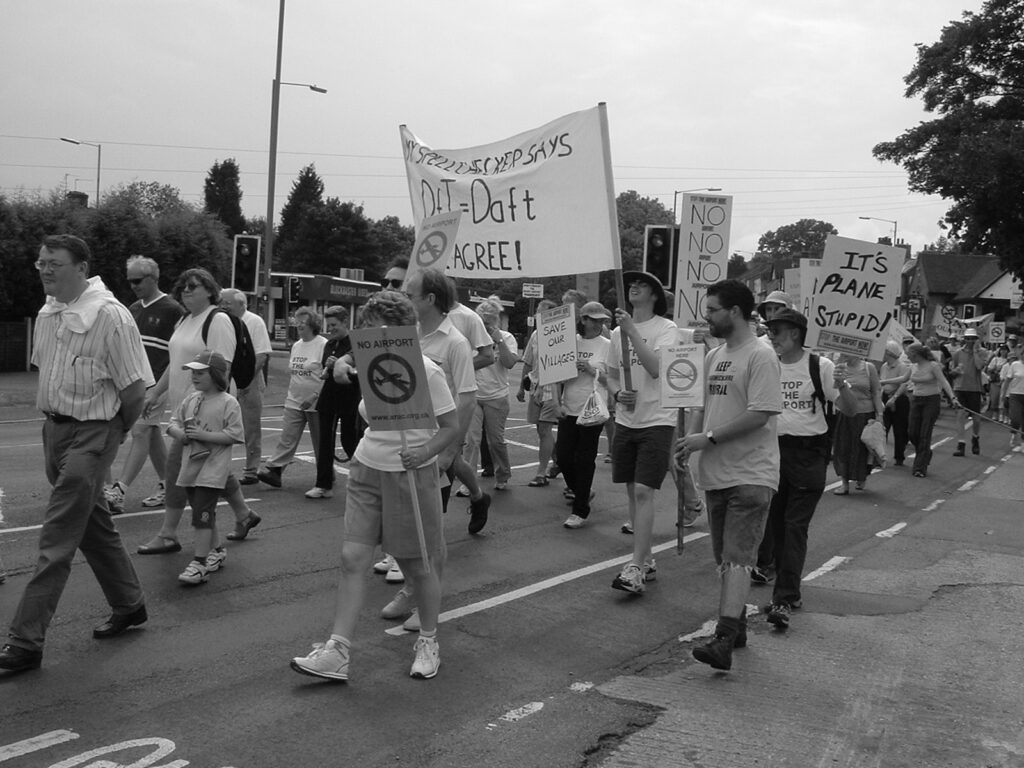
The original proposal was made in the summer of 2002 but we had to wait until December 2003 before heard the outcome of the consultation and the final decision. In the meantime the village was ‘blighted’ in that no-one could sell their house and some incomers were refused mortgages, Towards the end of 2003 we began to hear rumours that we were not to be the chosen site, but it was not until we heard the official decision that we could really open the champagne! Amusingly the reasons given for not choosing our site were all the ones we had cited in our consultation response!
So, Church Lawford and King’s Newnham are still here, 13 years later. And while this is the last instalment of our potted history, it is not, thank goodness, the last instalment in the story of our villages.
Long may they continue! For more info see:
http://www.coventrytelegraph.net/news/coventry-news/airport-plans-why-church-lawford-3168857
Liz Parvin
Background information and press clippings about the campaign at a local and regional level can be found via the link here, including a timeline with links to the relevant information.
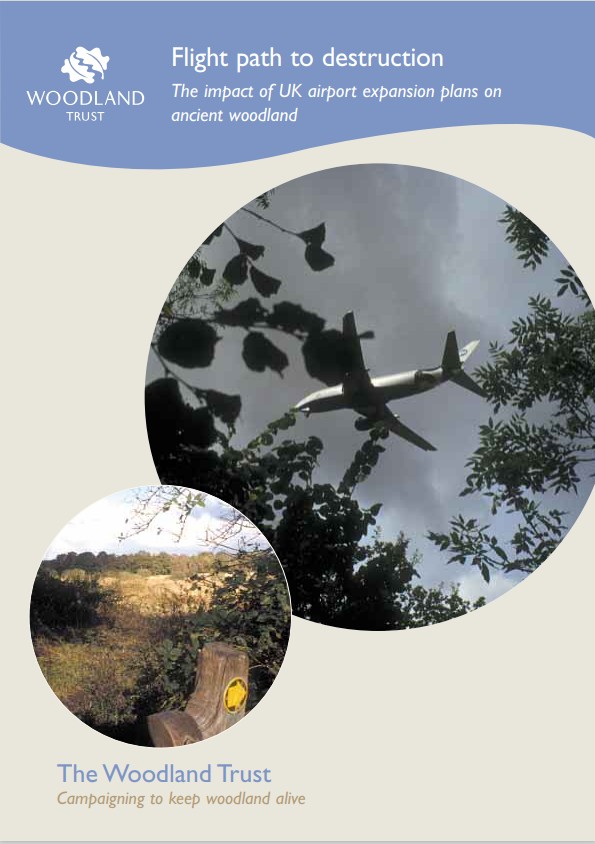
The Woodland Trust also produced a document outlining the threats to long-standing wooded areas such as Fulham Wood in Church Lawford and Chapel Wood in Kings Newnham.
The final 175 page Government document had just a few words documenting their findings regarding the “Midlands option” and the fact they did not support their original suggestion any more.
In addition to the overall response document lodged by the Anti-Rugby Airport Strategic Coordinating Group, which will be lodged in this archive in due course, there was also a response document produced by the Wolston, Brandon and Bretford Anti-Airport Action Group, and a copy of this is held in Rugby Library. That group fully supported the overall Coordinating Group, but ensured their parishioners specific issues were collated.
It is perhaps not surprising how well these considered responses have stood the test of time, and 20 years later the general points made still hold true. For example the point was made that advances in telecommunication would have reduced the need to fly, and also warned of the impact on climate change.
